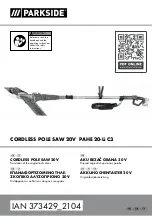
13 ENGLISH
24.
Disconnect the plug from the power source
and/or the battery pack from the power tool
before changing blade or servicing.
25.
Stopper pin which locks the cutter head down
is for carrying and storage purposes only and
not for any cutting operations.
26.
Do not use the tool in the presence of flamma
-
ble liquids or gases.
The electrical operation of
the tool could create an explosion and fire when
exposed to flammable liquids or gases.
27.
Use only flanges specified for this tool.
28.
Be careful not to damage the arbor, flanges
(especially the installing surface) or bolt.
Damage to these parts could result in blade
breakage.
29.
Make sure that the turn base is properly
secured so it will not move during operation.
30.
For your safety, remove the chips, small
pieces, etc. from the table top before
operation.
31.
Avoid cutting nails. Inspect for and remove all
nails from the workpiece before operation.
32.
Make sure the shaft lock is released before the
switch is turned on.
33.
Be sure that the blade does not contact the
turn base in the lowest position.
34.
Hold the handle firmly. Be aware that the saw
moves up or down slightly during start-up and
stopping.
35.
Make sure the blade is not contacting the
workpiece before the switch is turned on.
36.
Before using the tool on an actual workpiece,
let it run for a while. Watch for vibration or
wobbling that could indicate poor installation
or a poorly balanced blade.
37.
Wait until the blade attains full speed before
cutting.
38.
Stop operation immediately if you notice any-
thing abnormal.
39.
Do not attempt to lock the trigger in the on
position.
40.
Be alert at all times, especially during repeti-
tive, monotonous operations. Do not be lulled
into a false sense of security. Blades are
extremely unforgiving.
41.
Always use accessories recommended in this
manual. Use of improper accessories such as
abrasive wheels may cause an injury.
42.
Take care when slotting.
43.
Some dust created from operation contains
chemicals known to cause cancer, birth
defects or other reproductive harm. Some
examples of these chemicals are:
•
lead from lead-based-painted material
and,
•
arsenic and chromium from chemical-
ly-treated lumber.
Your risk from these exposures varies,
depending on how often you do this type
of work. To reduce your exposure to these
chemicals: work in a well ventilated area and
work with approved safety equipment, such as
those dust masks that are specially designed
to filter out microscopic particles.
44.
To reduce the emitted noise, always be sure
that the blade is sharp and clean.
45.
The operator is adequately trained in the use,
adjustment and operation of the machine.
SAVE THESE INSTRUCTIONS.
WARNING:
DO NOT let comfort or familiarity
with product (gained from repeated use) replace
strict adherence to safety rules for the subject
product. MISUSE or failure to follow the safety
rules stated in this instruction manual may cause
serious personal injury.
Important safety instructions for
battery cartridge
1.
Before using battery cartridge, read all instruc-
tions and cautionary markings on (1) battery
charger, (2) battery, and (3) product using battery.
2.
Do not disassemble battery cartridge.
3.
If operating time has become excessively
shorter, stop operating immediately. It may
result in a risk of overheating, possible burns
and even an explosion.
4.
If electrolyte gets into your eyes, rinse them
out with clear water and seek medical atten-
tion right away. It may result in loss of your
eyesight.
5.
Do not short the battery cartridge:
(1)
Do not touch the terminals with any con-
ductive material.
(2)
Avoid storing battery cartridge in a con-
tainer with other metal objects such as
nails, coins, etc.
(3)
Do not expose battery cartridge to water
or rain.
A battery short can cause a large current
flow, overheating, possible burns and even a
breakdown.
6.
Do not store the tool and battery cartridge in
locations where the temperature may reach or
exceed 50 °C (122 °F).
7.
Do not incinerate the battery cartridge even if
it is severely damaged or is completely worn
out. The battery cartridge can explode in a fire.
8.
Be careful not to drop or strike battery.
9.
Do not use a damaged battery.
10.
The contained lithium-ion batteries are subject
to the Dangerous Goods Legislation require-
ments.
For commercial transports e.g. by third parties,
forwarding agents, special requirement on pack-
aging and labeling must be observed.
For preparation of the item being shipped, consult
-
ing an expert for hazardous material is required.
Please also observe possibly more detailed
national regulations.
Tape or mask off open contacts and pack up the
battery in such a manner that it cannot move
around in the packaging.
11.
Follow your local regulations relating to dis-
posal of battery.
SAVE THESE INSTRUCTIONS.
Содержание DLS714Z
Страница 3: ...2 2 1 3 Fig 5 1 2 1 Fig 6 1 2 Fig 7 1 Fig 8 1 Fig 9 1 2 Fig 10 1 Fig 11 1 Fig 12 3 ...
Страница 4: ...1 2 2 Fig 13 1 1 Fig 14 Fig 15 1 1 3 4 5 3 2 2 Fig 16 1 2 Fig 17 Fig 18 Fig 19 4 ...
Страница 5: ...1 2 Fig 20 1 Fig 21 1 2 3 4 5 Fig 22 1 2 Fig 23 1 2 3 Fig 24 2 1 Fig 25 1 2 4 3 Fig 26 2 1 3 Fig 27 5 ...
Страница 9: ...1 2 3 Fig 53 1 Fig 54 Fig 55 1 2 Fig 56 1 Fig 57 1 2 3 Fig 58 2 1 5 4 3 Fig 59 1 2 3 Fig 60 9 ...
Страница 10: ...1 2 3 Fig 61 1 Fig 62 10 ...














































